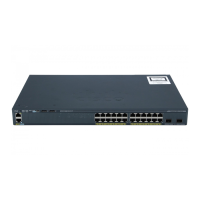is an aggregate-port learner if it learns addresses by aggregate (logical) ports. The learn method must be
configured the same at both ends of the link.
When a device and its partner are both aggregate-port learners, they learn the address on the logical port-channel.
The device sends packets to the source by using any of the ports in the EtherChannel. With aggregate-port
learning, it is not important on which physical port the packet arrives.
PAgP cannot automatically detect when the partner device is a physical learner and when the local device is
an aggregate-port learner. Therefore, you must manually set the learning method on the local device to learn
addresses by physical ports. You also must set the load-distribution method to source-based distribution, so
that any given source MAC address is always sent on the same physical port.
You also can configure a single port within the group for all transmissions and use other ports for hot-standby.
The unused ports in the group can be swapped into operation in just a few seconds if the selected single port
loses hardware-signal detection. You can configure which port is always selected for packet transmission by
changing its priority with the pagp port-priority interface configuration command. The higher the priority,
the more likely that the port will be selected.
The switch supports address learning only on aggregate ports even though the physical-port keyword is
provided in the CLI. The pagp learn-method command and the pagp port-priority command have no
effect on the switch hardware, but they are required for PAgP interoperability with devices that only
support address learning by physical ports, such as the Catalyst 1900 switch.
When the link partner of the switch is a physical learner, we recommend that you configure the switch as
a physical-port learner by using the pagp learn-method physical-port interface configuration command.
Set the load-distribution method based on the source MAC address by using the port-channel load-balance
src-mac global configuration command. The switch then sends packets to the physcial learner using the
same port in the EtherChannel from which it learned the source address. Only use the pagp learn-method
command in this situation.
Note
Related Topics
Configuring the PAgP Learn Method and Priority, on page 130
EtherChannel Configuration Guidelines, on page 120
Default EtherChannel Configuration, on page 119
Monitoring EtherChannel, PAgP, and LACP Status, on page 135
Layer 2 EtherChannel Configuration Guidelines, on page 122
PAgP Interaction with Virtual Switches and Dual-Active Detection
A virtual switch can be two or more core switches connected by virtual switch links (VSLs) that carry control
and data traffic between them. One of the switches is in active mode. The others are in standby mode. For
redundancy, remote switches are connected to the virtual switch by remote satellite links (RSLs).
If the VSL between two switches fails, one switch does not know the status of the other. Both switches could
change to the active mode, causing a dual-active situation in the network with duplicate configurations
(including duplicate IP addresses and bridge identifiers). The network might go down.
To prevent a dual-active situation, the core switches send PAgP protocol data units (PDUs) through the RSLs
to the remote switches. The PAgP PDUs identify the active switch, and the remote switches forward the PDUs
to core switches so that the core switches are in sync. If the active switch fails or resets, the standby switch
Catalyst 2960-XR Switch Layer 2 Configuration Guide, Cisco IOS Release 15.0(2)EX1
OL-29424-01 113
Configuring EtherChannels
Port Aggregation Protocol

